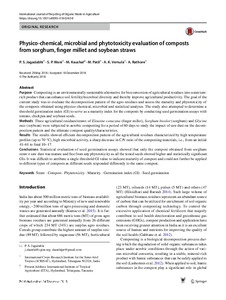| dc.contributor.author | Jagadabhi, P.S. |
| dc.contributor.author | Wani, S.P. |
| dc.contributor.author | Kaushal, M. |
| dc.contributor.author | Patil, M. |
| dc.contributor.author | Vemula, A.K. |
| dc.contributor.author | Rathore, A. |
| dc.date.accessioned | 2019-12-04T11:30:08Z |
| dc.date.available | 2019-12-04T11:30:08Z |
| dc.date.issued | 2018 |
| dc.identifier.citation | Jagadabhi, P.S., Wani, S.P., Kaushal, M., Patil, M., Vemula, A.K. & Rathore, A. (2018). Physico-chemical, microbial and phytotoxicity evaluation of composts from sorghum, finger millet and soybean straws. International Journal of Recycling of Organic Waste in Agriculture, 1-15. |
| dc.identifier.issn | 2195-3228 |
| dc.identifier.uri | https://hdl.handle.net/20.500.12478/5200 |
| dc.description | Open Access Journal; Published online: 24 Dec 2018 |
| dc.description.abstract | Purpose
Composting is an environmentally sustainable alternative for bioconversion of agricultural residues into a nutrient-rich product that can enhance soil fertility/microbial diversity and thereby improve agricultural productivity. The goal of the current study was to evaluate the decomposition pattern of the agro-residues and assess the maturity and phytotoxicity of the composts obtained using physico-chemical, microbial and statistical analyses. The study also attempted to determine a threshold germination index (GI) to serve as a maturity index for the composts by conducting seed germination assays with tomato, chickpea and soybean seeds.
Methods
Three agricultural residues/straws of Eleusine coracana (finger millet), Sorghum bicolor (sorghum) and Glycine max (soybean) were subjected to aerobic composting for a period of 60 days to study the impact of saw dust on the decomposition pattern and the ultimate compost quality/characteristics.
Results
The results showed efficient decomposition pattern of the agricultural residues characterized by high temperature profiles (up to 70 °C), high microbial activity, a sharp decrease in C/N ratio of the composting materials, i.e., from an initial 41–61 to final 10–17.
Conclusions
Statistical evaluation of seed germination assays showed that only the compost obtained from sorghum straw + saw dust was mature and free from any phytotoxicity as all the tested seeds showed higher and statistically significant GIs. It was difficult to attribute a single threshold GI value to indicate maturity of compost and could not further be applied to different types of composts as different seeds responded differently to the same compost. |
| dc.format.extent | 1-15 |
| dc.language.iso | en |
| dc.rights | CC-BY-4.0 |
| dc.subject | Straw |
| dc.subject | Composts |
| dc.subject | Phytotoxicity |
| dc.subject | Maturity |
| dc.subject | Seed Germination |
| dc.title | Physico‑chemical, microbial and phytotoxicity evaluation of composts from sorghum, finger millet and soybean straws |
| dc.type | Journal Article |
| dc.description.version | Peer Review |
| cg.contributor.affiliation | International Crops Research Institute for the Semi-Arid Tropics |
| cg.contributor.affiliation | International Institute of Tropical Agriculture |
| cg.creator.identifier | Abhishek Rathore: 0000-0001-6887-4095 |
| cg.authorship.types | CGIAR multi-centre |
| cg.iitasubject | Grain Legumes |
| cg.iitasubject | Soybean |
| cg.journal | International Journal of Recycling of Organic Waste in Agriculture |
| cg.howpublished | Formally Published |
| cg.accessibilitystatus | Open Access |
| local.dspaceid | 102851 |
| cg.targetaudience | Scientists |
| cg.identifier.doi | https://dx.doi.org/10.1007/s40093-018-0240-8 |

